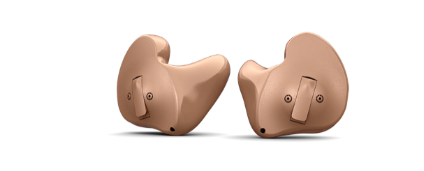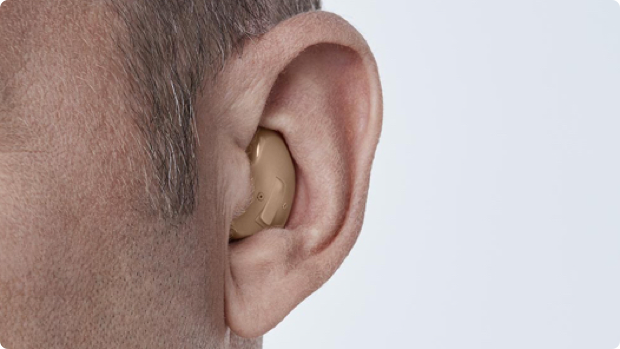In-the-Canal and In-the-Ear: ITC / ITE
Two solid performers in the category of hearing aids for people with moderate to severe hearing loss.

DEVICE APPEARANCE
How the ITC Hearing Aid Looks and Feels
The in-the-canal (ITC) and the in-the-ear (ITE) hearing aid styles fit in the category of the small hearing devices. The body of the hearing aid fits partially in the ear canal similar to the completely-in-canal, however it does have a higher profile making it more invisible compared to the CIC style. The ITC style, in a full-shell version is custom made to fully fill the bowl of the ear. The outside shell comes in an assortment of colours to blend with your skin tone. Shells for the ITE are available in full-shell and half-shell sizes.


AUDIO NOTES
ITC Hearing Aids Feature a Natural Sound Profile
When comparing the ITC/ITE option to the even smaller CIC, the slightly larger device offers more power. With more power available this style is suitable for those with more severe degrees of hearing loss; encompassing a larger range of hearing loss from mild to severe. A larger body equals a larger battery, and less frequent battery replacement. Because the ITE offers more “real estate” than the smaller ITC, is has more advantages such as volume control and program setting button on the device. While both these styles offer a cosmetic advantage and a comfortable custom fit, natural air flow into the ear canal is limited with small venting. This restrictive flow of air can result in wax build-up for the wearer. This wax can also interrupt the performance of the device, diligent care and maintenance is required.
Try Our Online
Hearing Test
Concerned about your hearing? Try our free no
obligation hearing screening test. This interactive test will
help you determine whether a professional consultation
would benefit you.

CUTTING-EDGE HEARING AIDS
Which Hearing Device Is Right for You?
BTE: Behind the Ear
Learn More
CIC: Completely in
Canal
Learn More
Extended Wear
Learn More
IIC: Invisible in Canal
Learn More
Mini-Canal
Learn More
ITC: In the Canal
Learn More
RIC: Receiver in Canal
Learn More
HEARING AID TECHNOLOGY
Options to Consider When Selecting a Hearing Aid
The ITC and ITE can accommodate larger, size 312 and 13 batteries and more technologies such as Bluetooth low energy technology. Bluetooth enables ITC hearing aids to connect to other devices including smartphones, TVs, computers, music players, and remote microphone accessories. Hands-free calls, and wireless connections to stereo audio is possible.

ANSWERS ABOUT HEARING AIDS AND MORE
Frequently Asked Questions
There are a few key differences between these types of hearing aids. The size of the device is the first difference. An in the canal device is a little bit larger than a completely in canal device. Because of this size difference, an in the canal hearing aid does not sit as deep in the ear canal as a completely in canal device. While still very discreet, an ITC hearing aid is more noticeable when worn. An in the canal hearing instrument is also more powerful, making them suitable for people with more severe cases of hearing loss.
Many ITC/ITE hearing aids come with volume control buttons on them, and the volume on some devices can also be controlled through a remote or mobile device. If you prefer one method of volume control over others, be sure to let our clinic staff know so they can recommend models of ITC/ITE devices that include the volume control features you want.
Over years of use, an in the canal or in the ear hearing aid will need to undergo re-casing. This is necessary because the cartilage in the ear canal can change shape slightly over time. This can be caused by aging, weight gain, or weight loss among other causes. You’ll know when your hearing device needs re-casing when it doesn’t fit in your ear as well as it used to. If this happens to you, book an appointment at one of our clinics to have your hearing aid adjusted, refitted and re-cased.
Our clinic staff will provide you with instructions on how to take care of your in the canal hearing aid before you leave with the device. It’s important that you follow these instructions carefully to ensure that the hearing aid is properly cared for. Also, since the hearing instrument sits in the ear canal, keeping your ears clean and free from earwax as much as possible will help to keep the device in top working order.
The best candidates for an in the canal hearing aid are people who want a device that is discreet but are also experiencing moderate to severe hearing loss. These devices offer the perfect balance of size and power. Many people find they have a much better appearance than larger devices such as behind the ear hearing aids, and they work better for their hearing needs than a smaller device like a completely in canal or invisible in canal hearing aid.
We would love to
hear from you!
assessment or hearing devices the professionals at NexGen Hearing
have the answers. Send us your contact information and we’ll be in
touch. Remember, there’s never any obligation and you’ll never be
pressured to make a purchase! We’re here to help!
Head Office
201 – 4500 West Saanich Rd.
Victoria, British Columbia
Canada, V8Z 3G2